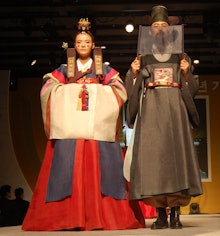It's Time For "Oriental" Fashion to Go Out Of Style

Two weeks ago, Joe Zee of ELLE Magazine listed "North Korea Chic" as a top fashion trend for Fall/Winter 2014 in an A to Z trends feature on their website, a decision that was met with righteous anger. In a chilling coincidence, just a few days later, reports emerged on the possible detention of an 85-year-old Korean War veteran by the North Korean regime.
Screen shot courtesy of the Washington Post.
Shortly thereafter, N stood for Naval instead on Zee's list; ELLE also apologized to "those [they] offended."
ELLE's gaffe illuminates the distance between pop talk about the North Korean dictatorship and its reality, but I stopped short of outrage, because it would be silly to expect more from fashion, one of the last remaining American spaces where the word "Oriental" is used regularly and without apology.
Nothing about ELLE's choice is new. You need not look further than fashion press to know that Orientalist fashion perpetuates myopic stereotypes bordering on fetishism. Katy Perry, anyone?
Every time Westernized Asian tropes are on the trend radar (trends are frequently cyclical and arbitrary), the powers that be load their copy with words like "exotic," "decadent," and "seductive", words which fly around "trend reports" hawking drapey silk garments printed with dragons, pantsuits made of stiff crepe de chine in cocktail party colors.
Image courtesy of Pinterest.
"Asian" iconography is often channeled by wealthy, non-Asian women, who presumably seek a commodified, sexualized, and very gendered Asianness.
"North Korea Chic" is just another example, albeit more extreme, of the fashion industry caricaturizing Asian identities.
The classical category "Oriental," left intact in fashion and perfumery, is an inherently racist one, based in a centuries-strong tradition in which Western cultures explore the aesthetics of Eastern cultures, mainly by dissecting and westernizing, picking and choosing, to make them more palatable to stylish Occidental consumers in the mood for something different.
Again, it's nothing new. Chinese brocade worked into silhouettes were engineered and popularized in European countries; art forms, symbols, and long-standing traditions have been subordinated and glamorized, reduced to mere style for years on end.
But it's 2013 now, and I'm tired of this.
Because I am half Korean and half Caucasian, I am acutely aware of the unglamorous things we don't talk about when "East Meets West": the endless fetishization of women who look more and less like me, the expectation of sensuality and submissiveness, being measured against a false idea of what my ethnicity is meant to imply. When I see things like ELLE's spread, I wonder why we have given fashion a pass on perpetuating exoticization, which disadvantages Asians (especially Asian women) for the sake of (primarily white) women's sense of self-expression.
I know very well what it feels like to have my identity compressed or stretched to suit someone else's specifications; that someone can profit from subordinating my identity is decidely not pretty.